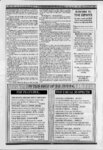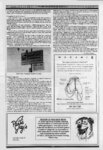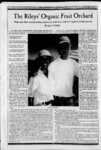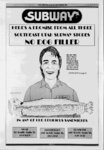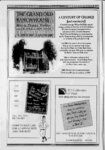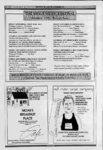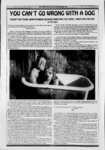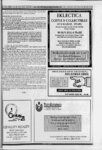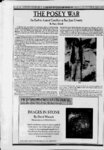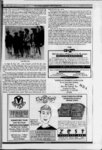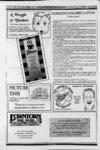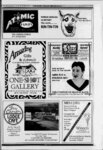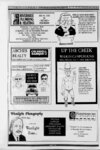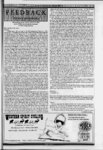| OCR Text |
Show a Dear Jim, about growth issues. When asked, "What do you see the Grand Valley looking like in 20 years?" Mr. Maupin replied that we have a "healthy" 2 growth rate here in the valley, and that means well have 225,000 people here in the year 2025. And 2 isn't very much. It's considered "healthy growth." Mr. Maupin is deluded (as are many y number it can't possibly be politicians) into believing that 2 is such an harmful. But consider this: the mathematical formula for a growing population's doubling time is expressed by the equation: Tj 70fp itty-bitt- the doubling time of the population, and p is the growth per unit of time. So for example: At a growth rate of 2 per year, the doubling time of the population, Tj, is 702 or 35 years. At a 2 growth rate, the population of the Grand Valley will double every 35 years. The more realistic growth rate for our area is actually 2.7 per year, which yields a population doubling time of a little under 26 years. Under the mathematical reality of a 2.7 growth rate, the facts are T2 is Year Grand Valley Population 1996 2022 2048 2074 103,000 206,000 412)00 824,000 It took all of histoiy until the 1980's for the Valley to reach a population of 80,000 people. At our current "healthy" 2.7 growth rate, it will be only 78 more to over 800,000 people. This is astronomical growth. yean to increase Political leaders, without even bothering to do the math, make statements that ignore reality. They tell us there is nothing wrong. People in positions of authority, like Mr. Maupin, should know that a population doubling time of 0 years, more than any other reality, will end life as we now experience it in Grand Junction. It assures our progeny of an astoundingly poorer living experience than we have today. Also, I must address the age-ol- d argument that "their land is their retirement." This argument infers that landowners have the right to change the use of their land when they sell. All landowners have the right to sell their land, but should all landowners have carte blanch to alter the use of the land when he or she decides to sell? This can be extremely damaging to the public interest. If all landowners seek to change to the most lucrative land use at the time it was sold, we will end up with plenty of houses and commercial space but very few productive farms. In Europe they have already realized where this system will take them. In England altering the use of farmlands is prohibited. This is how England, population around 33 million in a space one-thithe size of California, stays The Emerald Isle" and doesn't become (as we are) the Isle." Since taxes provide the infrastructure and maintenance that make development possible, the public has an interest in what happens to its surrounding lands. Development has a cumulative affect on the and safety. Therefore the public rightfully has an interest in public's well-beiand regulating type quality of development of private lands. You simply cannot more people and less regulation. The free market is driven by have simultaneously profits, not protection of the public. If we continue to use the current system of land exchange (and we will), tighter restrictions will eventually HAVE to be made on the conversion of land use. Lastly, I must discuss Mr. Maupin's blanket statement that "It's the people who just moved here who want to stop growth." This argument is designed to encourage people who have lived here a long time to fold their arms, look down their nose at newcomers and sniff, "What do they know? Damn relocatees!" But think for a minute... from where do these newcomers derive their perspective? More than likely areas ruined by growth. they came here to "escape" heavily populated, overly-pollutIt is they, ironically, who have the best perspective on growth because they have already experienced it to its logical end. Indeed, Grand Junction's leaders are guilty of false P.R. if they continue to lure people here by advertising Grand Junction as a peaceful, quiet, dean, safe, quaint town, with clean air and lovely views and then fill it up with tacky subdivisions, corrugated metal architecture, big box national retail outlets, and cars, cars, cars. Thanks for the opportunity to respond to the answers provided by our ten-fol- d, 25-3- rd oys-R-- Us ng Do you know the inconvenience you've caused me? I'm speaking here about the cover of your last issue. I can't tell you how many times a dim tourist came up to me. Zephyr in hand, and asked where the IMAX theater was. (Blustering I appreciate your humor, Jim, and I think you're kinda clever. But when I have to go around explaining that you're just being clever - well, it gets old. Disheartening, yes; but mostly tedious. So do me a favor and dumb down with the rest of us. I'll gladly lend you a few blonde jokes, for example, if you need any. non-respons- e) Mathew Gross Moab Editor s Note: Sorry Matt. It's not that I wanted dll of you to suffer the way I suffered during my ranger days at Arches. It's just that I wanted you to "understand me." Dear Jim Stiles, I would like to speak for a moment to all the free spirits who infest Moab every spring. It's just this: Quit leaving your bodily wastes behind every bush, rock, and tree in the desert. I can't tell you how many times I've found a nice camping spot, and when I inspected the area, found a big pile of shit behind the nearest bush. Even a cat buries his poop. And toilet paper is not a flag, to be left waving from your personal potty. Take it with you. (Oh my God, how can I touch my PEE!?) And take the rest of your trash with you too. A campfire ring is not a trash can. Cans do not bum up. difference in temperature, and completely different Except for a hundred-degre- e shares town scenery, my many things with Moab. I'm talking four new motels in the last five years, three new chain restaurants, several campgrounds, and a complete commitment to making money and providing the tourist with everything his little heart desires, no matter what it does to the town. Does Moab have an Imax yet? We do! And (you're going to be jealous) grizzly bears and wolves in cages, right outside the boundary of Yellowstone Park. You have bikers and jeepers, we have snowmobilers. I'll argue over which group is the most obnoxious and I'll win. Since West Yellowstone is completely surrounded by federal land, we have nowhere to expand to. Old buildings are being tom down and replaced by taller, fancier buildings. (A la Jackson Hole). There is no affordable housing; hell, there's no affordable property. Real estate is so valuable that the show has to be trucked out of town. We have a permanent population of 1,000 and about half of the employees needed to run the town during peak season who, of course, have nowhere to live. Yet our city fathers keep building motels and restaurants. A commercial than the whole town used is to slated I've be) for. development (larger heard, a I a a and Denny's, McDonalds, couple motels, a campground, and several new souvenir shops. When the INS came to town two years ago and rounded up 33 illegal Mexican ; immigrants, in the middle of the summer, the business owners were crying the blues because they had no one else who would work as hard for so little money, and live in slum housing besides. There was no one else to work, period. It's not unusual for people here to work two or even three jobs during the summer and winter, and get by on unemployment during the slack seasons. (That's when we go to Moab.) When Yellowstone Park superintendent Mike Finley proposed setting limits on - 67-ac- re T-sh-irt . ! i) (te m ; v, i i ife- 4Cv - if' r ed if I' ;.Yr, f. ffi' f-- - ex-may-or. Sincerely, &XwXWXv!v!w Anne Landman Glade Park, CO TOM TILL Photography 1 wait eight years for Stiles to do a cartoon of me and this is what he comes up with Maybe he should take up photography." r- - v |


